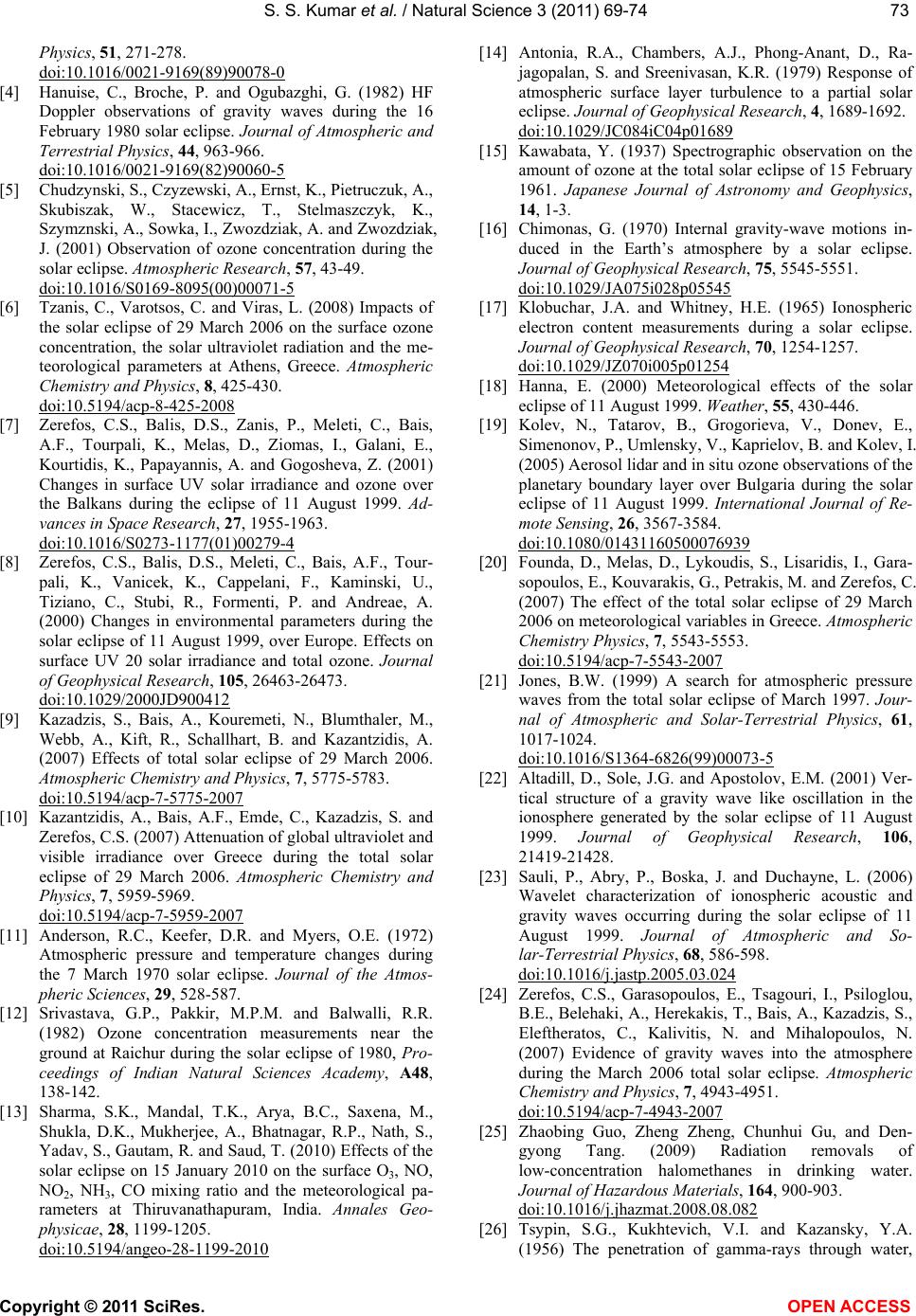
S. S. Kumar et al. / Natural Science 3 (2011) 69-74
Copyright © 2011 SciRes. OPEN ACCESS
7373
Physics, 51, 271-278.
doi:10.1016/0021-9169(89)90078-0
[4] Hanuise, C., Broche, P. and Ogubazghi, G. (1982) HF
Doppler observations of gravity waves during the 16
February 1980 solar eclipse. Journal of Atmospheric and
Terrestrial Physics, 44, 963-966.
doi:10.1016/0021-9169(82)90060-5
[5] Chudzynski, S., Czyzewski, A., Ernst, K., Pietruczuk, A.,
Skubiszak, W., Stacewicz, T., Stelmaszczyk, K.,
Szymznski, A., Sowka, I., Zwozdziak, A. and Zwozdziak,
J. (2001) Observation of ozone concentration during the
solar eclipse. Atmospheric Research, 57, 43-49.
doi:10.1016/S0169-8095(00)00071-5
[6] Tzanis, C., Varotsos, C. and Viras, L. (2008) Impacts of
the solar eclipse of 29 March 2006 on the surface ozone
concentration, the solar ultraviolet radiation and the me-
teorological parameters at Athens, Greece. Atmospheric
Chemistry and Physics, 8, 425-430.
doi:10.5194/acp-8-425-2008
[7] Zerefos, C.S., Balis, D.S., Zanis, P., Meleti, C., Bais,
A.F., Tourpali, K., Melas, D., Ziomas, I., Galani, E.,
Kourtidis, K., Papayannis, A. and Gogosheva, Z. (2001)
Changes in surface UV solar irradiance and ozone over
the Balkans during the eclipse of 11 August 1999. Ad-
vances in Space Research, 27, 1955-1963.
doi:10.1016/S0273-1177(01)00279-4
[8] Zerefos, C.S., Balis, D.S., Meleti, C., Bais, A.F., Tour-
pali, K., Vanicek, K., Cappelani, F., Kaminski, U.,
Tiziano, C., Stubi, R., Formenti, P. and Andreae, A.
(2000) Changes in environmental parameters during the
solar eclipse of 11 August 1999, over Europe. Effects on
surface UV 20 solar irradiance and total ozone. Journal
of Geophysical Research, 105, 26463-26473.
doi:10.1029/2000JD900412
[9] Kazadzis, S., Bais, A., Kouremeti, N., Blumthaler, M.,
Webb, A., Kift, R., Schallhart, B. and Kazantzidis, A.
(2007) Effects of total solar eclipse of 29 March 2006.
Atmospheric Chemistry and Physics, 7, 5775-5783.
doi:10.5194/acp-7-5775-2007
[10] Kazantzidis, A., Bais, A.F., Emde, C., Kazadzis, S. and
Zerefos, C.S. (2007) Attenuation of global ultraviolet and
visible irradiance over Greece during the total solar
eclipse of 29 March 2006. Atmospheric Chemistry and
Physics, 7, 5959-5969.
doi:10.5194/acp-7-5959-2007
[11] Anderson, R.C., Keefer, D.R. and Myers, O.E. (1972)
Atmospheric pressure and temperature changes during
the 7 March 1970 solar eclipse. Journal of the Atmos-
pheric Sciences, 29, 528-587.
[12] Srivastava, G.P., Pakkir, M.P.M. and Balwalli, R.R.
(1982) Ozone concentration measurements near the
ground at Raichur during the solar eclipse of 1980, Pro-
ceedings of Indian Natural Sciences Academy, A48,
138-142.
[13] Sharma, S.K., Mandal, T.K., Arya, B.C., Saxena, M.,
Shukla, D.K., Mukherjee, A., Bhatnagar, R.P., Nath, S.,
Yadav, S., Gautam, R. and Saud, T. (2010) Effects of the
solar eclipse on 15 January 2010 on the surface O3, NO,
NO2, NH3, CO mixing ratio and the meteorological pa-
rameters at Thiruvanathapuram, India. Annales Geo-
physicae, 28, 1199-1205.
doi:10.5194/angeo-28-1199-2010
[14] Antonia, R.A., Chambers, A.J., Phong-Anant, D., Ra-
jagopalan, S. and Sreenivasan, K.R. (1979) Response of
atmospheric surface layer turbulence to a partial solar
eclipse. Journal of Geophysical Research, 4, 1689-1692.
doi:10.1029/JC084iC04p01689
[15] Kawabata, Y. (1937) Spectrographic observation on the
amount of ozone at the total solar eclipse of 15 February
1961. Japanese Journal of Astronomy and Geophysics,
14, 1-3.
[16] Chimonas, G. (1970) Internal gravity-wave motions in-
duced in the Earth’s atmosphere by a solar eclipse.
Journal of Geophysical Research, 75, 5545-5551.
doi:10.1029/JA075i028p05545
[17] Klobuchar, J.A. and Whitney, H.E. (1965) Ionospheric
electron content measurements during a solar eclipse.
Journal of Geophysical Research, 70, 1254-1257.
doi:10.1029/JZ070i005p01254
[18] Hanna, E. (2000) Meteorological effects of the solar
eclipse of 11 August 1999. Weather, 55, 430-446.
[19] Kolev, N., Tatarov, B., Grogorieva, V., Donev, E.,
Simenonov, P., Umlensky, V., Kaprielov, B. and Kolev, I.
(2005) Aerosol lidar and in situ ozone observations of the
planetary boundary layer over Bulgaria during the solar
eclipse of 11 August 1999. International Journal of Re-
mote Sensing, 26, 3567-3584.
doi:10.1080/01431160500076939
[20] Founda, D., Melas, D., Lykoudis, S., Lisaridis, I., Gara-
sopoulos, E., Kouvarakis, G., Petrakis, M. and Zerefos, C.
(2007) The effect of the total solar eclipse of 29 March
2006 on meteorological variables in Greece. Atmospheric
Chemistry Physics, 7, 5543-5553.
doi:10.5194/acp-7-5543-2007
[21] Jones, B.W. (1999) A search for atmospheric pressure
waves from the total solar eclipse of March 1997. Jour-
nal of Atmospheric and Solar-Terrestrial Physics, 61,
1017-1024.
doi:10.1016/S1364-6826(99)00073-5
[22] Altadill, D., Sole, J.G. and Apostolov, E.M. (2001) Ver-
tical structure of a gravity wave like oscillation in the
ionosphere generated by the solar eclipse of 11 August
1999. Journal of Geophysical Research, 106,
21419-21428.
[23] Sauli, P., Abry, P., Boska, J. and Duchayne, L. (2006)
Wavelet characterization of ionospheric acoustic and
gravity waves occurring during the solar eclipse of 11
August 1999. Journal of Atmospheric and So-
lar-Terrestrial Physics, 68, 586-598.
doi:10.1016/j.jastp.2005.03.024
[24] Zerefos, C.S., Garasopoulos, E., Tsagouri, I., Psiloglou,
B.E., Belehaki, A., Herekakis, T., Bais, A., Kazadzis, S.,
Eleftheratos, C., Kalivitis, N. and Mihalopoulos, N.
(2007) Evidence of gravity waves into the atmosphere
during the March 2006 total solar eclipse. Atmospheric
Chemistry and Physics, 7, 4943-4951.
doi:10.5194/acp-7-4943-2007
[25] Zhaobing Guo, Zheng Zheng, Chunhui Gu, and Den-
gyong Tang. (2009) Radiation removals of
low-concentration halomethanes in drinking water.
Journal of Hazardous Materials, 164, 900-903.
doi:10.1016/j.jhazmat.2008.08.082
[26] Tsypin, S.G., Kukhtevich, V.I. and Kazansky, Y.A.
(1956) The penetration of gamma-rays through water,